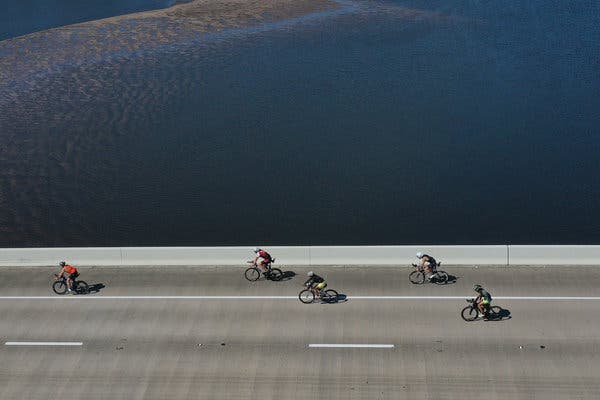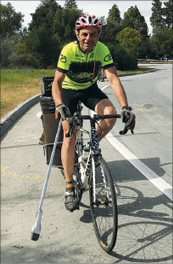Advertisement
Marathons. Cycling Races. Triathlons. So many have been wiped out, but organizers are already planning how to bring them back.

July 1.
That’s the date Joe De Sena has circled on his calendar. It’s when the chief executive of Spartan, the endurance and obstacle race company, believes he will again be gathering thousands of people to crawl under barbed wire, scale hills of mud, swim through icy water and jump over fire.
“We are tribal creatures,” De Sena said from his farm in central Vermont, where he has been sheltering in place with 20 family members for the past month. “We’re not going to live our lives hiding from each other behind our couches.”
In the endurance-sports world, De Sena may be the biggest optimist out there, because at this moment, even with disease curves flattening, it can be hard to imagine thousands of people massing together on a start line, drinking from communal fluid stations and huffing through a grueling racecourse.
In March, De Sena furloughed 75 percent of his staff of about 400 and cut the pay of those who remained, to help ease the pain of losing $9 million in profits. Now, he and other race organizers are starting to imagine life on the other side of Covid-19, becoming some of the first people in sports to actively plan for the next normal.
“Once we get out of this, what is the product going to look like?” said Dave McGillivray, the race director for the Boston Marathon, which was supposed to take place Monday, and dozens of other races organized by his company. “Is it going to change temporarily or forever?”
Some 5,000 road races, roughly 775 cycling events and more than 250 multisport events (triathlons and duathlons) will not happen this spring. Athletes have cabin fever, and racing directors and event companies are juggling a series of bad alternatives that are producing financial losses and angry customers in the short term, and that could cannibalize the industry come fall.
“I don’t think events like ours will go back anytime soon,” said Carrie Panek, an owner of Koz Events, which owns and manages 15 races in the San Diego area.
Koz Events — which Panek runs with her husband, Tobias — recently laid off all five employees, including the Paneks so they could collect unemployment. New race registrations and revenue have gone to zero. Rescheduling for later in the year has its own problems. There is already an endurance event scheduled for nearly every weekend in San Diego County, but Carrie Panek is determined to find a way to hold races that meet health guidelines. The events may be smaller, and not have the same thrill of a crushing horde on the start line, but she insists they are going to happen. “We’re going to figure out a way to survive,” she said.
The economics of the endurance-event business make a pandemic particularly problematic. Registration fees produce as much as 80 percent of revenues, and 80 to 90 percent of that money is spent on expenses weeks and months in advance of race day, including purchases of medals, T-shirts and permits. A canceled race owned by a mom-and-pop business that has to issue refunds or deferrals can sink the event or the business, said Rich Harshberger, the chief executive at Running U.S.A., an industry trade group
Ironman, the world’s best-known triathlon series, is transferring competitors from canceled or postponed events to races later in the year or in 2021, rather than giving refunds. Not everyone is happy about that.
Barbara Marinoni, who lives in suburban Toronto, spent more than $1,000 to register for a half-Ironman in Muskoka, Ontario, in July, which has already been canceled, and for a full Ironman in August in Mont-Tremblant in Quebec, which probably will be, since Quebec’s provincial government has canceled all sports and cultural events until Aug. 31.
“I would rather have the money refunded, or I think at least there should be some portion refunded,” said Marinoni, a supply chain executive who isn’t ready to commit to races that won’t happen for another 16 months.
Andrew Messick, chief executive of Ironman, said the company chose a policy of race substitutions instead of refunds because most athletes he heard from were not interested in getting money back. They just want to race and to know when they can. “The training and the races provide a structure to their lives that they find really valuable,” Messick said.
Most race operators are far smaller than Ironman and may have less flexibility.
“If the summer gets wiped out, we will have to get very creative,” said Stephen Del Monte, owner of DelMoSports, which owns and operates a half-dozen races in Philadelphia and South Jersey.
Del Monte and other race directors are planning to create virtual options, in which people time themselves and set their own courses, and more space for participants in real-life events. In the short term, swimming may be eliminated from some triathlons, since there are very few pools open where people can train. Transition areas for triathletes — the places where athletes shift from the swim to the bike and the bike to the run — will have to be larger.
Also, for every kind of event, instead of a designated start time, athletes might be told to start whenever they want within a window of an hour or two.
Dennis Wilson, 64, of Anaheim, Calif., has been running road races for 40 years, and he said he would feel comfortable in a corral wearing a mask, “but I don’t want to get into a corral until I see the numbers flattening.”
“We’re going to have to get some new ideas for the corrals,” said Jack Staph, the owner and race director of the Cleveland Marathon, referring to the typically cramped starting areas.
Staph had expected 13,000 runners for the various races of the marathon weekend, May 16-17. He had an insurance policy, but cancellation because of a pandemic was not covered. Nearly 80 percent of his budget had already been spent. Now everyone who was registered can either do the race virtually or defer for up to two years.
“I think we’re going to come back, maybe slowly, but I expect the virtual race will be a part of every event going forward,” Staph said.
Last month, Jeff Simecek had to cancel the race he organizes, the Statesman Capitol — a 10-kilometer race in Austin, Texas, for 25,000 runners that had been scheduled for April 5. His insurance policy included pandemic coverage, and he reached out to the city of Austin to try to find an alternative date. But there were no options.
In many areas, all the postponing and rescheduling has created a glut of events during the final four months of the year.
Ryan Coelho, whose USA Productions owns and operates a triathlon that takes place every month from April through October in Northern California, is trying to figure out how to reschedule the Half Moon Bay Triathlon, one of his most popular, without overtaxing his resources, the market or his participants, who could sustain injuries if they do too many races too quickly.
“People are not in the water right now, and you can’t just throw them back in,” Coelho said. “I have to think of all the other races that are happening in the area, and will my athletes even be available.”
De Sena, Spartan’s chief executive, said his company would come back strong. Spartan is now focusing on creating content about training and nutrition and on producing merchandise so the company is more diverse. He is also thinking of how his events will change.
“Maybe,” he said, “we’ll have people swim through Purell.”


